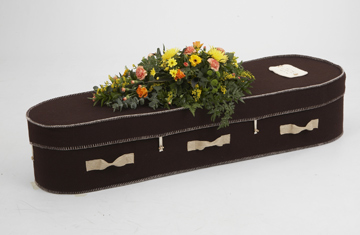
To help it survive — and thrive — in Britain's shrinking textile industry, Hainsworth, a 225-year-old, family-run wool mill in West Yorkshire, England, has developed niche uses for wool. Its product range includes the uniforms worn by the Royal Guards at Buckingham Palace, the felt lining inside Steinway pianos and the interior headlining used in Rolls-Royce and Bentley automobiles. But it is one of Hainsworth's most recent, and most unique, new products that's making the company's competitors look sheepish: woolen coffins.
Thanks to a growing demand for green funerals in Britain, Hainsworth's Natural Legacy caskets — each woven from the fleece of three sheep and capable of holding 840 lb. (380 kg) — have begun to carve out a share of the U.K.'s coffin market, which typically numbers around 500,000 a year. Domestic sales now total 50 to 60 a month, and Adam Hainsworth, the company's commercial director, is confident the firm can capture 5% of the U.K. market within a few years, and ultimately reach a market share of 15% to 20%. "We expect it to become our biggest-selling product," he says. Moreover, Hainsworth has also begun selling the fully biodegradable caskets in the U.S. and other foreign markets.
The idea for woolen coffins came about thanks to a bit of sheer luck. A marketing student who was interning for Adam Hainsworth discovered that in 1667, Parliament — hoping to bolster the textile industry — passed a law requiring all corpses be buried in a woolen shroud. Good idea, Hainsworth thought, though clearly in this day and age something sturdier would be required. So with the help of a funeral director he knew, he built a prototype casket — bulked up with recycled cardboard — and took it to JC Atkinson, the U.K.'s largest manufacturer and distributor of coffins. The company liked the idea and agreed to help shepherd further development and act as distributor. Six months later, at a June 2009 trade show, Hainsworth took the wraps off the woolen coffin.
The coffin's exterior is 100% British wool with six jute handles attached; the interior is lined with cotton. Each coffin also has an embroidered woolen nameplate. To keep it all natural, no dyes are used, so the coffins only come in two colors: white or brown. "There's a beauty about them; they're soft and comfortable-looking," Hainsworth says. But how biodegradable is wool? According to Hainsworth, one local farmer collects wool waste from the mill to fertilize his rhubarb fields. "It does rot down fairly well," Hainsworth says.
Certainly, the timing is good, as the popularity of green funerals in Britain is rapidly increasing. The Natural Death Center, based in Winchester in southern England, says the number of natural burial sites in the U.K. has grown from 54 to 260 in 10 years, at a pace of around 20 a year. And all those sites report that their annual burial rates are growing 30% a year. "That's feeding demand for eco-coffins," says Rosie Inman-Cook, the center's manager. Other green caskets are typically made from cardboard, wicker and even papier-mâché, but Tim Mahony, owner of the Mahony & Ward funeral home in Leeds, says the woolen coffins "have become accepted much faster than some of the other green types. They seem to fit the bill for what people want." Even if they have to pay extra for it. Retail prices for Hainsworth's woolen coffins range from $960 to $1,290, a bit more than the $800 average cost for a standard wooden coffin in Britain.
Seeing how popular the caskets are at home, Hainsworth has begun knitting together a team of overseas distributors and is now selling coffins in Finland, Holland, Germany and Australia. The company also recently set up a U.S. distribution arm that has so far sold around 100 caskets. That's not many in a country that sees 2.5 million burials a year. But with coffins in the U.S. costing around $2,000 on average — with bronze and copper versions going for more than $10,000 — Hainsworth caskets are a relative bargain. And demand for environmentally friendly funerals is starting to pick up in the U.S., says Joe Sehee, executive director of the Green Burial Council in New Mexico, citing surveys that show 1 in 5 older Americans want a green send-off. And Hainsworth is confident that strong word of mouth from satisfied customers will also help open the U.S. market to its fluffy creations.
Indeed, the company has received numerous testimonials from family members in praise of the woolen coffins. "Some of them are real tearjerkers," Hainsworth says. "It's a privilege to help people like that." Funeral director Mahony says that in his experience, the woolen coffins even have a comforting effect on the bereaved. "They give people a nice feeling," he says. "It's like wrapping a loved one in a warm blanket."
